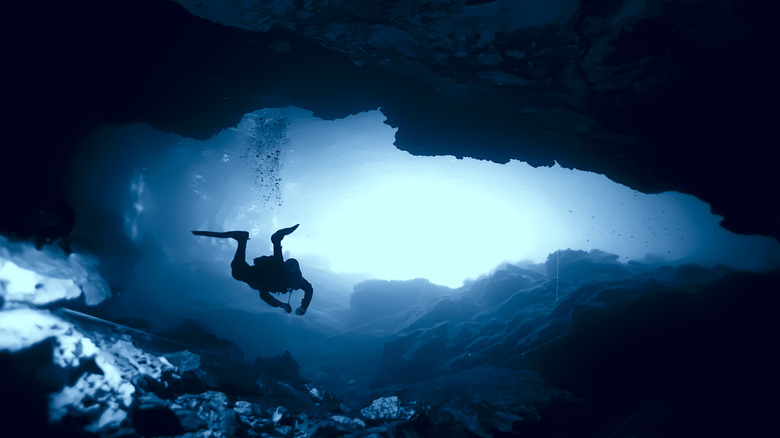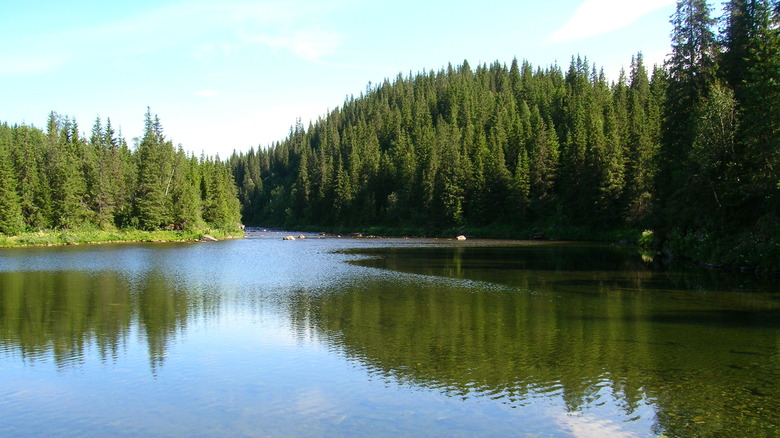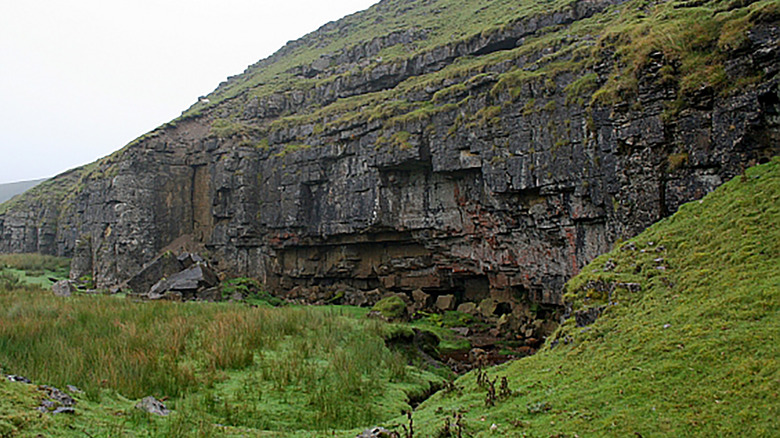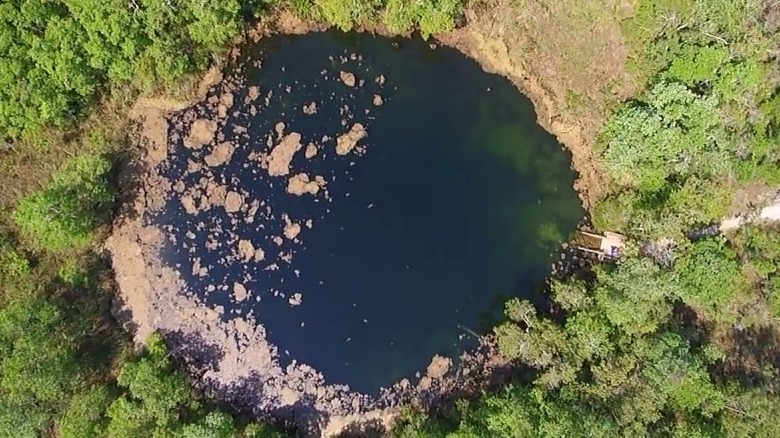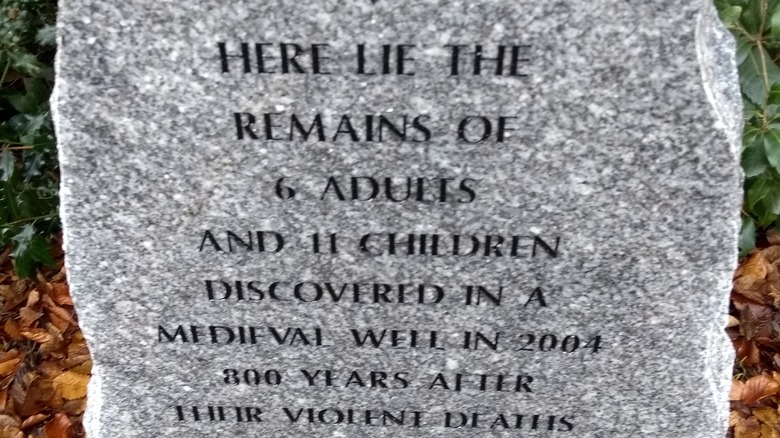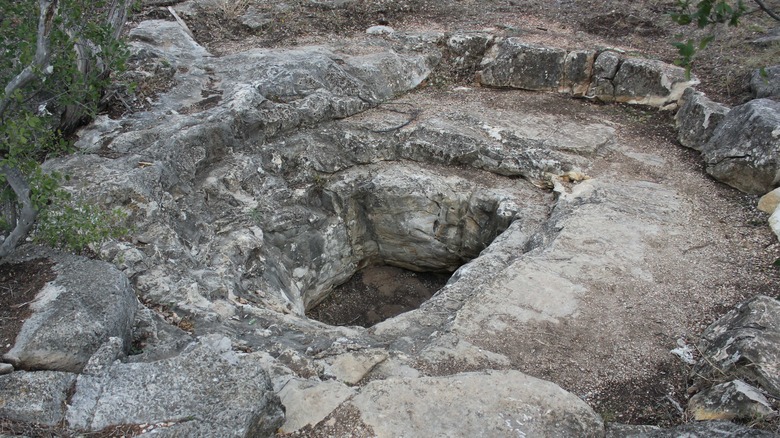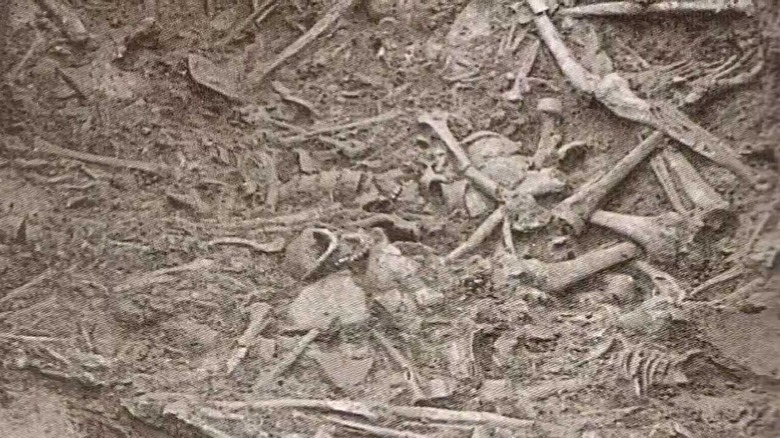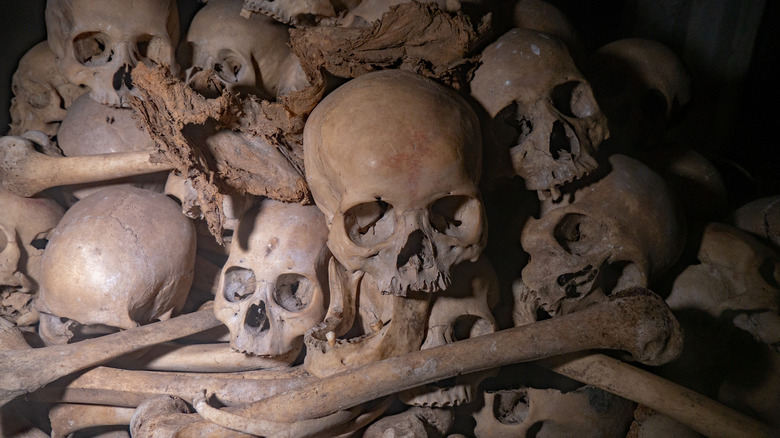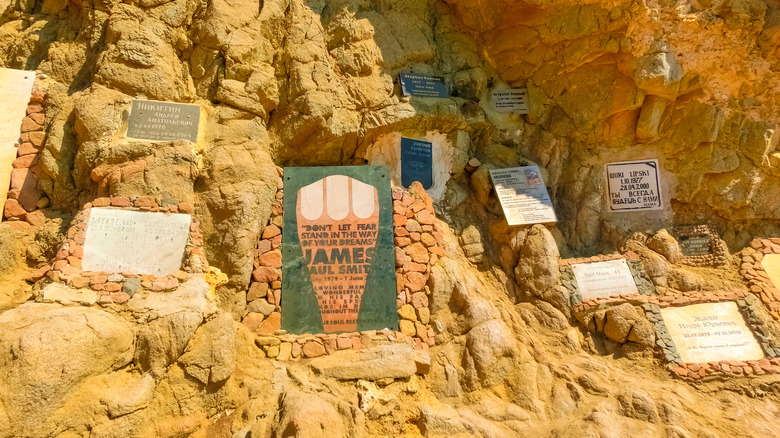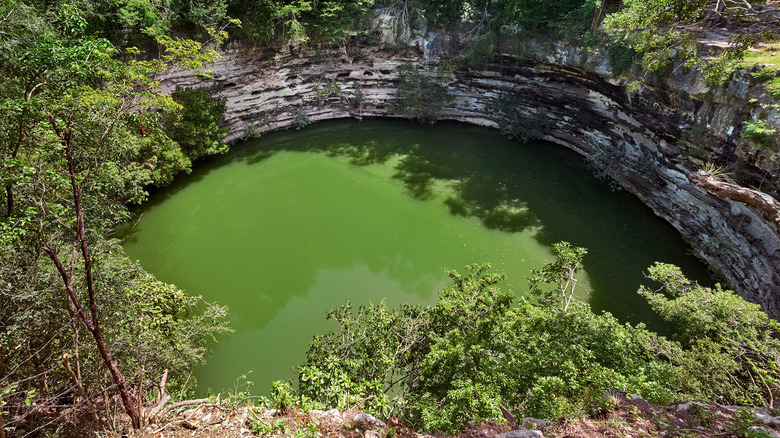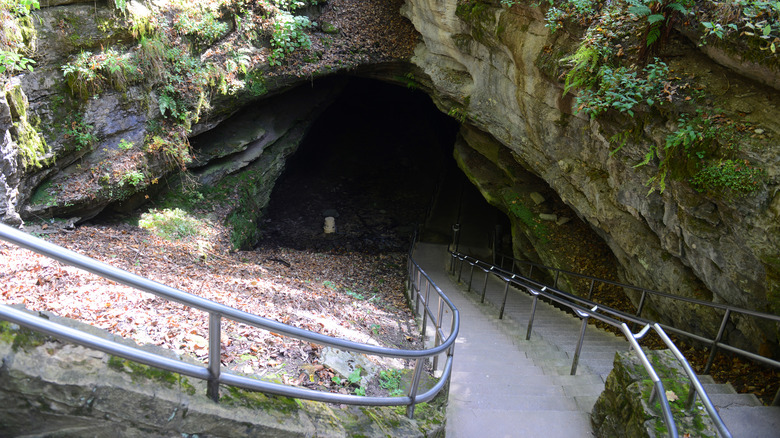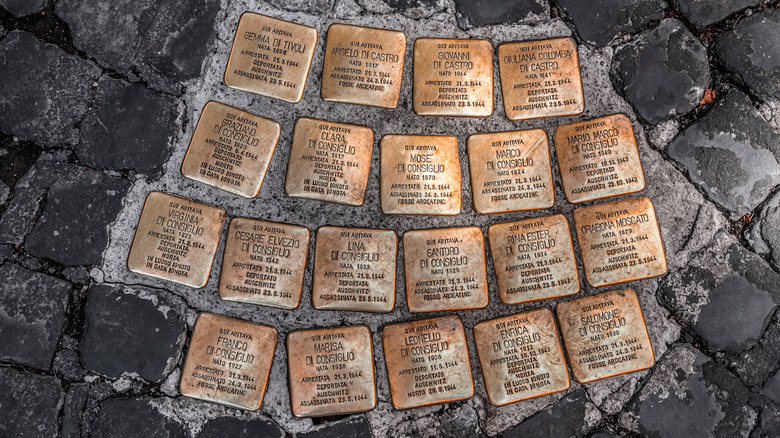Holes That Have Taken The Most Human Lives
The term "deadly holes" begs a good, Freudian giggle. But as Mark Twain once said, "the secret source of all humor itself is not joy but sorrow." The holes in question — caves, sinkholes, even wells — can easily turn into death traps. People fall down wells, sinkholes swallow whole buildings, and caving can be one of the deadliest pursuits out there. Spelunkers have to navigate breathtakingly narrow passages, underground streams, subterranean pools of near-freezing water called sumps that can be yards deep, ledges, pits (the list goes on) and do it all in the dark, isolated from the nearest emergency services. Some of these structures, natural or man-made, are literally cases of "you go in and you don't come out."
The following are some holes with a nasty habit for taking human lives — and not just by accident. Stories include murder and anti-Semitism to gang violence and genocide. Here are some holes that have taken the most human lives.
Plura Incident: Brothers Till The End
As a BBC article describes, the Plura River in central Norway appears dramatically, rising out of a pond that is actually the opening to a flooded cave system; the Plura, for a part of its length, runs underground. The article goes on to say that this makes it a favorite for scuba diving, with the highlight being the dry cave of Steinugleflaget over a mile in (which is also the second entry to the caverns). This was the destination for five Finnish divers in 2014.
What happened next is highlighted in the documentary, "Diving Into The Unknown," plus several written accounts. Scuba website Mpora recounts how one of the divers' gear got tangled in a narrow passageway, causing him to breathe harder and faster. Under normal circumstances, this is normal with any exertion. But underwater, with sensitive breathing equipment, any quickening of breath can result in deadly carbon dioxide poisoning. That diver, Jari Huotarinen, quickly perished. According to Mpora, another diver, Jari Uusimaki, came across the body and panicked, resulting in another death by carbon dioxide. The BBC report says the remaining divers were not then equipped to retrieve their friends but later returned to recover the bodies in a solemn show of brotherhood.
Mossdale Caverns Tragedy: Rain, Rain, Go Away
Located in the Yorkshire Dales National Park in northern England, the Mossdale Caverns were first explored in 1941 by spelunker Bob Leakey. According to the park's website, Mossdale tracks over six miles underground, with several passages only a few inches high, making the cavern a challenge even for professional cavers. But all the skill in the world could not prevent disaster when, in 1967, seven spelunkers went in ... right before a downpour.
A retrospective in The Independent describes how the caverns, naturally riven with sumps even on dry days, flooded within minutes. One caver turned back and lived, but the other six were swept away into the deepest recesses. Despite a headline-making recovery effort, the danger was too great; The Independent reports the bodies remain in the cave to this day.
Mossdale permanently highlighted the dangers of spelunking. Today, the Council of Northern Caving Clubs clearly warns "Mossdale Caverns is a seriously flood-prone cave, with passages only a few minutes into the entrance filling to the roof in flood and passages further into the cave sumping with only a small rise in river levels. Mossdale must only be considered following at least two days of dry weather and with an absolute certainty of no rain during your trip."
Eagle's Nest: Still Waters Run Deep
Say "Florida" and images of beaches or Disney may spring to mind, but the Sunshine State is also a popular cave-diving destination for intrepid scuba enthusiasts. Popular, but not safe, notes WTSP. One of its destinations, the Eagle's Nest, actually a flooded sinkhole complex with numerous passageways and over 300 feet deep, is listed as an "extremely advanced" dive site, per FloridaCaves.com, due to the depths but also the relative isolation of the destination. "Do not take this lightly," the site warns.
But those warnings still did not prevent the 12 confirmed deaths the Eagle's Nest has claimed since 1981. Ironically, several of these tragedies involve expert divers. ABC News describes how two divers, both of professional-grade and already familiar with the site, died there in 2016. The report surmises that water pressure, along with nitrogen narcosis (a deep-water condition marked by impaired thinking) could have played a part.
The most recent death was in 2018. An article in the Orlando Sentinel recounts a diver died at just 150 feet down. Officials considered the Eagle's Nest so dangerous that they closed the attraction in 1999, only to have scuba enthusiasts lobby successfully for the sinkhole's reopening in 2003.
The Norwich Well: The Truth Emerges
Settled by the Anglo-Saxons as early as the fifth century, Norwich is one of those English cities in which no matter where an archeologist digs, something will be found. But as the BBC reports, researchers in 2004 were stunned when they uncovered a medieval well containing 17 skeletons. Dating to the 12th or 13th centuries, the well contained the bones of 11 children ranging in ages from 2 to 15, with the rest being adult men and women. According to the BBC, the find baffled scientists until DNA revealed the remains belonged to an extended family of Jews, and a grim chapter in Norwich history came to light.
A follow-up article in the Forward by Renee Ghert-Zand details how Norwich had a large Jewish population by 1135, much of it centered around the well. Ghert-Zand details how these early English Jews were invited by King Stephen to work in banking and lending money, a common economic practice today but one that was then banned by Christianity. Financing-for-profit inevitably led to conflicts between Jews and other communities that culminated in flat-out massacres; as the BBC and Forward note, the bodies in the well, thrown in head-first, are presumed an anti-Semitic ethnic cleansing. A memorial now stands at a Jewish graveyard in the city.
Dead Man's Hole: Just What The Name Says
Most caverns form through the action of water, but the Texas State Historical Association surmises Dead Man's Hole, a pit near the town of Marble Falls, is the result of naturally occurring gas pressure. Seven-feet wide and 160-feet deep, this tourist draw is, however, famous for all the wrong reasons.
As related on Atlas Obscura, the hole gained infamy and its sinister name during the American Civil War when it was used by Confederate vigilantes to "vanish" local Southerners with Unionist sympathies (or suspected to have them). Some of the unlucky were shot and thrown in, others were hanged from a tree overlooking the hole until almost dead and then cut down into the void. If those victims managed to survive both experiences, the poisonous fumes at the bottom finished them off. Most tallies, including Atlas Obscura's, count 17 dead, but an article on the local tourism website speculates as many as 36 could have met their end at Dead Man's Hole. That same article says that to this day, the site's harrowing reputation is used as an admonishment for bad behavior — "You better change your ways or you'll end up in Dead Man's Hole" is still a common catchphrase in the region.
Roman Well of Belgrade: A European "Tradition"
Atlas Obscura describes how the Roman Well of Belgrade, in modern-day Serbia, most likely got its name via a bit of "Glories of Rome" spin-doctoring by officials of the much-later Austro-Hungarian Empire. The piece goes on to say the well was probably built in the early 1700s as a straightforward water source, but other sources say the well is much older and much darker.
For example, Belgrade Live reports the well was already constructed by 1494, the same year 37 traitors to the city were thrown in, left to starve, and then tossed a knife so they could kill and eat each other. Astonishingly, this was not an uncommon practice at the time when you wanted to execute someone slowly. Medieval Europe was dotted with specially made dungeons called oubliettes, all of which amounted to dropping people into a particularly deep hole, forgetting about them, and letting dehydration or hunger do the rest.
But the sinister story of the Roman Well doesn't end there. Balkan Insight recounts how a would-be assassin was thrown in and left to die in 1882, and Atlas Obscura lists an incident in 1954 when a woman was killed and hefted in by her mentally disturbed husband.
Talheim Death Pit: A Tale As Old As Time
Without written records, how peaceful or warlike Neolithic Europe (roughly 7000 to 2300 B.C.E.) is up for debate. Quoted in an article on Ancient Origins, anthropologist R. Brian Ferguson asserts it was a tranquil period, with organized warfare only appearing with the advent of the Bronze Age. Several grisly archeological finds beg to differ, including the Talheim Death Pit, as noted by Live Science.
Historian Jan Turek, in his 2020 study, "Archaeology of Domestication, 8 – Linear Pottery Culture in Europe & Bohemia," details how the pit, discovered in 1983 in Germany and dated to around 5000 B.C.E., indicates war had long since been "invented." The result of a massacre, the Talheim Death Pit is essentially a mass grave holding the jumbled remains of "16 children, nine adult males, seven adult women, and two more adults of indeterminate sex." Turek notes all had traumas ranging from arrows to more serious adze (a type of ax) wounds that were most likely the cause of death. Additionally, none of the skeletons exhibited defensive damage. This suggests they were fleeing when killed, and their haphazard placement in the grave suggests little to no funeral rites. Finally, Turek points out that many Talheim victims had weapon-related injuries that had healed, suggesting violence was already a routine event in their lifetimes.
Phnom Sampeau: What Lies Beneath
The cave of Phnom Sampeau was just one site involved in the Cambodian Genocide, aka the Killing Fields. A study by the University of Minnesota states 1.5 to 3 million people died in an orgy of murder orchestrated by the Khmer Rouge, a Marxist regime in power from 1975 to 1979. As History documents, dictator Pol Pot attempted to create a "master race" by removing intellectuals and other city-dwellers to ill-conceived social engineering projects in the countryside that were, in effect, death sentences. Almost 40% of the 1975 population of 7.5 million was wiped out as enemies of the state or died from starvation, illnesses, or overwork. But officials still had to get rid of the bodies.
Located near the city of Battambang, Phnom Sampeau was perfect. A deep cave with a natural skylight, Atlas Obscura reports that victims were bludgeoned and thrown in, or pushed in directly. It is not recorded how many people died at Phnom Sampeau, but a memorial composed of stacked skulls commemorates the tragedy. Atlas Obscura notes that, eager to move on from the past, locals will highlight the temples and monastery at the site and the cave's latest incarnation as a bat sanctuary and monkey habitat.
Blue Hole of Dahab: Beware Of The Rapture
A marine sinkhole on Egypt's Red Sea Riviera, the Blue Hole is north of the town of Dahab and a popular cave diving spot. The Egyptian national tourism authority lists it as "somewhat dangerous," which is a deceptively rosy description; an article on Slate calls it the "Diver's Cemetery" and includes a photo of the memorial plaques to just some of the dead dotting the surrounding cliffs. Slate counts at least 130 lives lost at the Blue Hole of Dahab in just the last 15 years, but locals put the number at 200, notes The Guardian. Spiegel calls it the "World's Deadliest Dive Site."
What makes the Blue Hole of Dahab so dangerous is not geography, but depth. According to Slate, the bottom is 394 feet down, far deeper than the 130-feet limit for recreational diving and a challenge for even professionals. But at just 100 feet, the water pressure can interfere with the gas mixture in both scuba tanks and the blood stream, leading to what Healthline calls the "rapture of the deep." A type of nitrogen narcosis marked by hallucinations, euphoria, and poor judgment, Healthline warns the condition can impel divers go deeper or even forget their environment. Slate details how one afflicted diver filmed himself taking off his breathing apparatus before he drowned.
Sacred Cenote: Come, Little Children
An article at ThoughtCo describes how study of the Maya of Central America only became serious research in the early 1900s, and at the time, historians were dead-set on the idea the civilization was composed of peaceful time-worshippers. In 2021, the picture is more ... complicated.
Not far from the magnificent ruins of Chichén Itzá in Mexico's Yucatan Peninsula is a flooded sinkhole the maps call the Sacred Cenote, but colloquially is the "Well of Sacrifice." A piece at Ancient Origins records the site as being sacred to Chaac, the Maya god of rain and an extremely important persona to an agrarian society. According to Forbes, dredging revealed the bones of at least 200 individuals of all sexes, but with half being children between the ages of 4 and 6. The article does clarify to say some of the victims were already dead (and even disarticulated) when their remains were thrown into the cenote, but many others were alive. Ancient Origins notes a 72-foot drop to the water, a survivable fall. But the same water that cushioned the landing almost certainly assured death by drowning.
Forbes notes this was not an isolated cult center, either: Mineral analysis of the remains show victims were procured from all over southern modern-day Mexico.
Mammoth Caves: Into The Darkness
A UNESCO World Heritage Site and the second most popular single sightseeing destination in the United States after Niagara Falls, Mammoth Cave in Kentucky is an undisputed natural wonder and the first cave to be a tourist attraction. But away from the electric lighting and pedestrian-friendly pathways, the cavern, now a national park, has an unsettling reputation.
The National Park Service notes Native American burials at Mammoth were common, as were accidents; the skeleton of an Indigenous miner was found pinned under a five-ton boulder. Much later, in 1839, the caverns were turned into a tuberculosis sanatorium. According to an article at Only In Your State, five patients expired at the cave. The same article details the 1925 death of Floyd Collins, an early spelunker who perished in the cave's unexplored passages (Mammoth's full extent is still unknown). Add to that stories of ghosts, grave robbing, and the fact that body-horror writer H.P. Lovecraft used the caverns as the setting for "The Beast In The Cave," and suddenly the site doesn't seem so tourism friendly.
And the body count continues to rise: Mammoth Cave claimed its latest victim in 2012; the Bowling Green Daily News reports a visitor died there when his heart stopped.
Ardeatine Massacre: Kill Them All
World War II practically wrote the book on atrocity — the ghastly tally of the Nazi death camps include not only 6 million Jews murdered but also 3 million Catholics (via the Catholic News Agency), up to 500,000 Roma, 10,000 homosexuals — the list continues. But the Holocaust is also so overwhelming that many smaller massacres get overlooked, like one at Fosse Ardeatine, or the Ardeatine Caves, in 1944.
The Jewish Virtual Library gives a virtual play-by-play: Just outside Rome, the Fosse Ardeatine, actually a catacomb, became the grave of 335 Italians and Jews in retaliation for an Italian resistance bombing the day before that resulted in the killing of several policemen and bystanders. The attack would later claim 42, but when the death toll for the police hit 33, the reprisal order came. Kill 10 Italian citizens for every one dead policeman.
But, according to the Holocaust Encyclopedia, somebody couldn't do math. Initially, death-row inmates were marked, but there weren't enough so other prisoners were included. That still didn't meet the 330 quota, so random Italians were pulled off the street. However, by the time the Germans reached the Fosse Ardeatine, they had five extra victims. Rather than let five go, the Encyclopedia relates how the Nazis assassinated all 335 in the catacombs and then dynamited the site.
